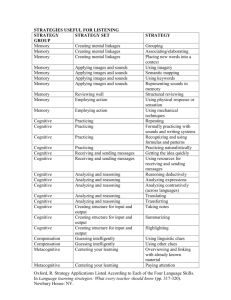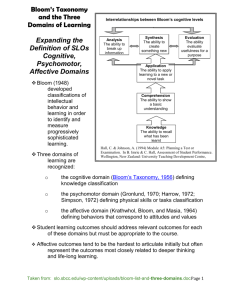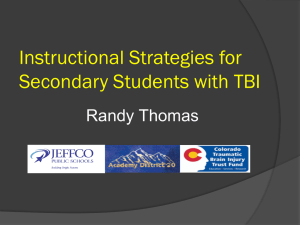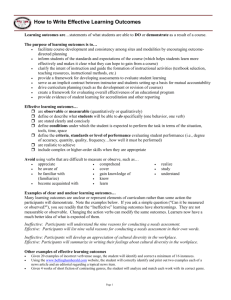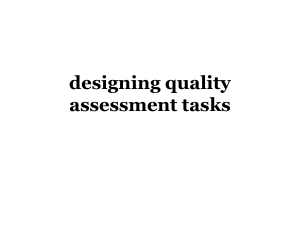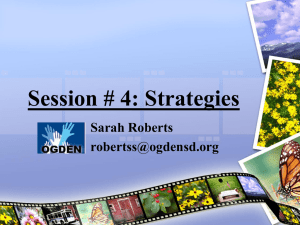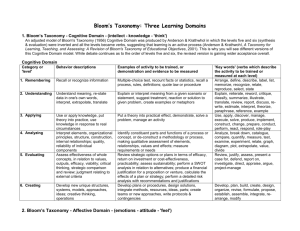The Domains of Learning : comprehensive taxonomy of educational
advertisement
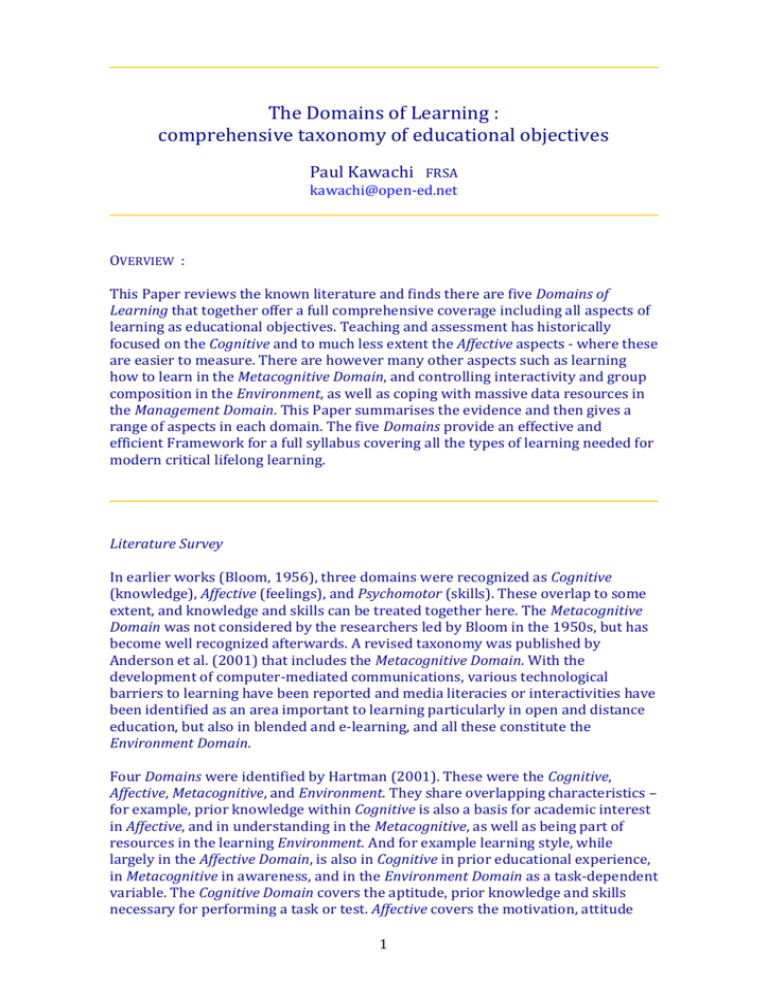
The Domains of Learning : comprehensive taxonomy of educational objectives Paul Kawachi FRSA kawachi@open-ed.net OVERVIEW : This Paper reviews the known literature and finds there are five Domains of Learning that together offer a full comprehensive coverage including all aspects of learning as educational objectives. Teaching and assessment has historically focused on the Cognitive and to much less extent the Affective aspects - where these are easier to measure. There are however many other aspects such as learning how to learn in the Metacognitive Domain, and controlling interactivity and group composition in the Environment, as well as coping with massive data resources in the Management Domain. This Paper summarises the evidence and then gives a range of aspects in each domain. The five Domains provide an effective and efficient Framework for a full syllabus covering all the types of learning needed for modern critical lifelong learning. Literature Survey In earlier works (Bloom, 1956), three domains were recognized as Cognitive (knowledge), Affective (feelings), and Psychomotor (skills). These overlap to some extent, and knowledge and skills can be treated together here. The Metacognitive Domain was not considered by the researchers led by Bloom in the 1950s, but has become well recognized afterwards. A revised taxonomy was published by Anderson et al. (2001) that includes the Metacognitive Domain. With the development of computer-mediated communications, various technological barriers to learning have been reported and media literacies or interactivities have been identified as an area important to learning particularly in open and distance education, but also in blended and e-learning, and all these constitute the Environment Domain. Four Domains were identified by Hartman (2001). These were the Cognitive, Affective, Metacognitive, and Environment. They share overlapping characteristics – for example, prior knowledge within Cognitive is also a basis for academic interest in Affective, and in understanding in the Metacognitive, as well as being part of resources in the learning Environment. And for example learning style, while largely in the Affective Domain, is also in Cognitive in prior educational experience, in Metacognitive in awareness, and in the Environment Domain as a task-dependent variable. The Cognitive Domain covers the aptitude, prior knowledge and skills necessary for performing a task or test. Affective covers the motivation, attitude 1 and decision to initiate performance, the Metacognitive is understanding how the task is performed, and the ability to self-monitor, evaluate and plan own learning, and the Environment Domain is defined as the social or physical forum in which learning occurs. Student surveys have confirmed these four Domains are involved as facilitating learning or as the case may be as barriers to learning. Rezabek (1999) found that barriers to learning in distance education could be categorized as situational, institutional, or dispositional. The first two are in the Environment Domain, and the third is in the Affective. Garland (1993) found a fourth category of epistemological barriers concerning the technical difficulty, prerequisite knowledge and academic interest or relevance, and this category would be in the Cognitive Domain. And Leggett & Persichitte (1998) found a fifth category concerning student support and study skills, which would be in the Metacognitive Domain. The Case for a Management Domain The Management Domain covers an evolving field, and is being established to bring into account the knowledge and skills to be learnt by students in the newly emerging learning society and knowledge-creating society using the Internet since 1991. Learners are faced with an information overload in most cases - with electronic access through the Internet to libraries, news-groups, blogs, email, voice-over-internet chat, as well as face-to-face meetings, print, radio, television, and so on. Learners must develop coping strategies and skills, in order to filter this massive amount of information to obtain appropriate material in a suitable quality for assimilation and learning. The student has to spend time and effort to judge the quality, validities and reliabilities of the incoming information. Time management is included here, since this is an overarching influence on the information management skills. Reading and writing communication skills are also within this Management Domain. There are a host of literacies included here. The student function in this Domain is to imagine and then access information (or if necessary to design research to collect data to generate this information), search, evaluate and select appropriate information, and then to construct knowledge. The student needs to interact with ideas, data, information, and prior knowledge - preferably within a regulated system as opposed to a chaotic situation. The student needs to interact with other individuals, resources and organizations. Overall, this Management Domain involves learning efficient and effective communication processes. The Barriers to Learning There are many reports in the literature on the various barriers to learning (Bloom et al, 1956 ; Anderson et al, 2001 ; Hartman, 2001 ; Rezabek, 1999 ; Garland, 1993 ; Leggett & Persichitte, 1998). Students report finding the content too difficult, or the language poses a problem, or that there own computer skills are inadequate. These together with other barriers or aspects to be learnt and surmounted during their studies are listed in TABLE 1 below and categorised according to domain. 2 TABLE 1 : Barriers suggested from the Literature Domain Barrier 1. COGNITIVE content too difficult, illiterate 2. AFFECTIVE low interest, not fun, no motivation 3. METACOGNITIVE slow feedback, low self-esteem 4. ENVIRONMENT no space, competing family duty 5. MANAGEMENT no time, no library, coping stress The five Domains of Learning are summarised in TABLE 2 with their respective coverage related directly to the above Barriers reported by students learning. TABLE 2 : The Domains of Learning according to Barriers to be Overcome Domain Barrier 1. COGNITIVE aptitude knowledge and skills 2. AFFECTIVE motivations and group orientation 3. METACOGNITIVE self-reflection on learning 4. ENVIRONMENT social physical and virtual forum 5. MANAGEMENT coping storing and retrieval The Domains of Learning can be expanded as ;Cognitive Domain : the aptitude, prior knowledge and skills necessary for performing a task or test, and the content knowledge and reflective critical thinking skills to be learnt Affective Domain : the motivation, attitude and decision to initiate performance, including the will to reduce own autonomy in order to achieve group tasks Metacognitive Domain : understanding how the task is performed, and the ability to self-monitor, evaluate and plan own future learning, and the willingness to help others to learn Environment Domain : the social or physical forum and virtual or augmented reality in which learning occurs, including any group characteristics Management Domain : coping critically with massive amounts of information to obtain appropriate material in a suitable quality for learning, and time management 3 This Paper is available online at http://www.open-ed.net/library/domains.pdf The Domains of Learning are also reported in a presentation at http://www.open-ed.net/library/domains.ppt REFERENCES : Anderson, L.W., Krathwohl, D., Airasian, P.W., Cruikshank, K.A., Mayer, R.E., Pintrich, P.R., Raths, J., & Wittrock, M.C. (Eds.) (2001). A taxonomy for learning, teaching and assessing : A revision of Bloom's taxonomy of educational objectives. New York : Longman. Bloom, B.S., Engelhart, M.D., Furst, E.J., Hill, W.H., & Krathwohl, D.R. (1956). Taxonomy of educational objectivities : The classification of educational goals : Handbook I : Cognitive domain. New York : David McKay. Garland, M. (1993). Student perceptions of the situational, institutional, dispositional and epistemological barriers to persistence. Distance Education, 14 (2), 181-198. Hartman, H.J. (2001). Developing students’ metacognitive knowledge and skills. In H.J. Hartman (Ed.). Metacognition in learning and instruction. Kluwer Academic Publishers. Leggett, W.P., & Persichitte, K.A. (1998). Blood, sweat and TEARS : 50 years of technology implementations obstacles. TechTrends, 43 (3), 33-36. Rezabek , R. (1999). Barriers to distance education enrollment. Proceedings of the TeleLearning Conference, October. Austin, TX. 4

